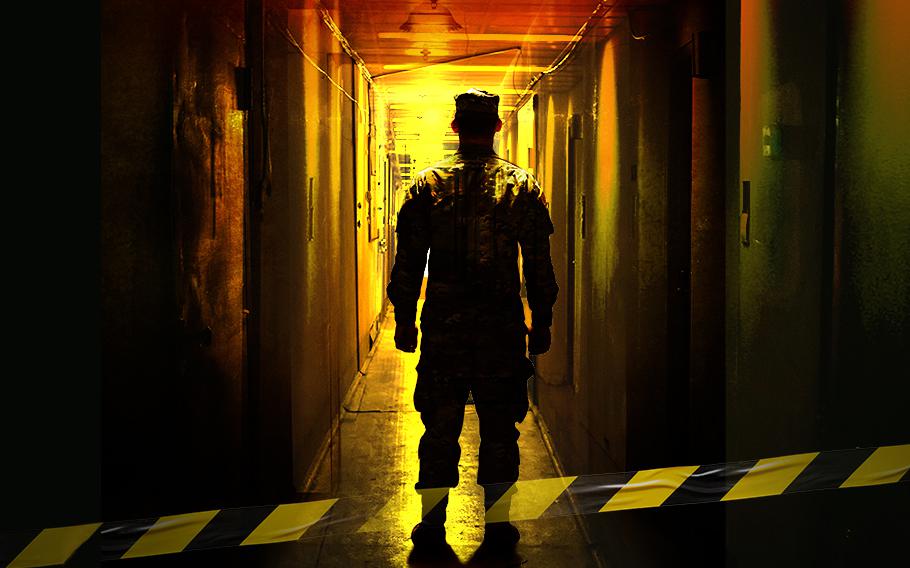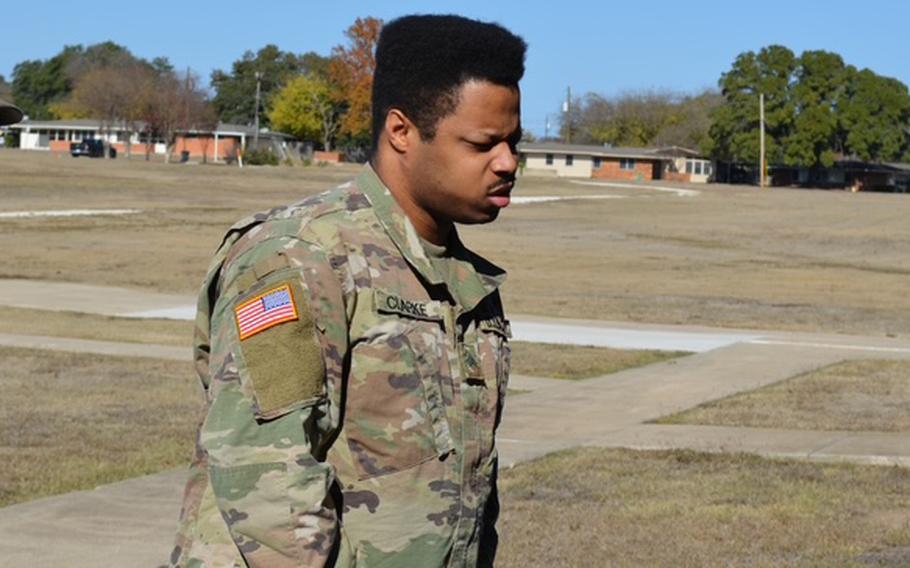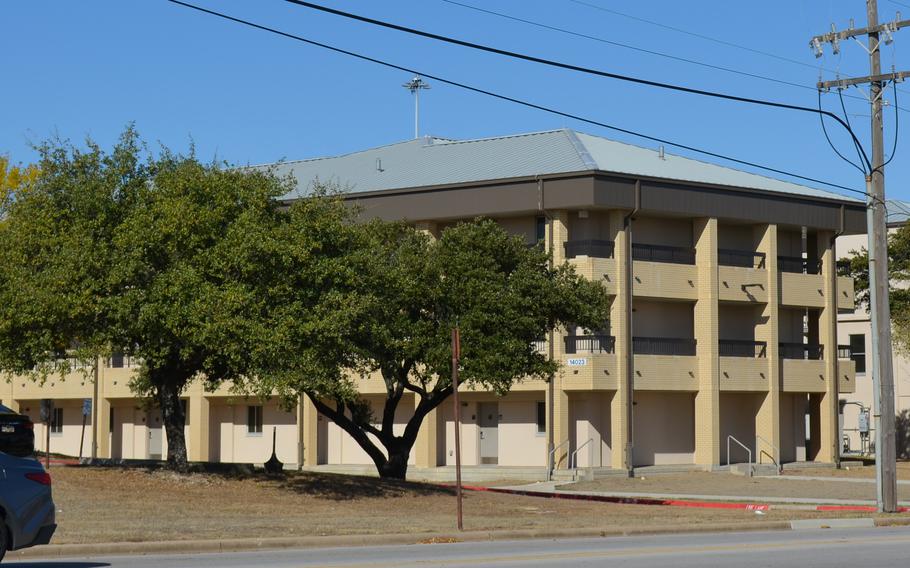
Four female soldiers were attacked by a man with a weapon in their barracks rooms at Fort Hood, Texas. The attacks took place in a 18-month span. During that time, base officials chose not to release a public warning and instead alerted soldiers through the chain of command. (Noga Ami-rav/Stars and Stripes)
AUSTIN, Texas — Mayra Diaz was a 17-year-old high school senior working toward enlisting in the Army when she heard the news that Spc. Vanessa Guillen, another young Hispanic woman with dreams of the military, was killed at Fort Hood in April 2020.
As Guillen’s case ignited a criminal investigation and justice reforms at the base and across the military, Diaz watched from California. She hesitated to enlist.
“I remember my mom crying to me and telling me not to leave,” Diaz said. “In the end, I knew that it was what was best for me career-wise and spiritually and emotionally, just to get away from home. So, I made the decision to join the military despite what happened to [Guillen], knowing that it could happen to me.”
Diaz reassured her mother that nothing like what happened to Guillen would happen to her.
But it did.
Diaz arrived at Fort Hood in February 2022. Another female soldier living near her on the east end of the Army post in central Texas was held at knifepoint in a barracks room and sexually assaulted the following month. Diaz never heard about it, or a similar attack that had occurred the previous year.
Even after a man forced his way into Diaz’s room with a gun in the middle of night July 15, 2022, raped her and nearly strangled her to death, there would be no public alert or warning from Army officials at the base.
Only after another female soldier, who was being held at gunpoint in her barracks room in October 2022, escaped naked and screaming for help did Fort Hood soldiers and the public learn Sgt. Greville Clarke had spent 18 months preying on the women living and working around him at the base.
A review of the Army Criminal Investigation Division’s investigative reports into Clarke’s crimes show investigators noted a pattern of similarities in attacks against female soldiers in the barracks just days after friends found Diaz in her room. The reports also showed CID did not investigate the first attack in 2021, instead left it to the military police force, which closed the investigation after two months because DNA evidence collected from the scene was inconclusive.
The investigations began at Fort Hood during a period of upheaval for the Army. After Guillen’s disappearance and death at the hands of another soldier in 2020, service officials ordered an independent review of the base that exposed practices among military police, criminal investigators and leaders created a permissive environment for sexual assault to occur. It also found the base did not do enough to prevent crime from occurring.
Many of the reforms that stemmed from the Fort Hood report relating to CID, the military justice system and policies on treatment of victims of sexual violence were begun in late 2021 and some are still in the process of being fully implemented. For CID, those reforms included increasing the number of civilian agents that work for the crime division, and more training opportunities. Agents have better access to investigative tools for digital forensics and shorter turnaround times from the evidence lab and from leaders on approval for investigation strategies such as consented monitoring of conversations.

Sgt. Greville Clarke enters the Lawrence H. Williams Judicial Center at Fort Cavazos, Texas, on Dec. 10, 2024, for a hearing. (Rose L. Thayer/Stars and Stripes)
CID also has a mandate to prevent crime, and the review of Fort Hood called on better relationships between investigators, base leaders and the surrounding civilian community to do so.
Lane Allen, the special agent who took charge of the Fort Hood CID office this year, confirmed the division weighed the idea with base leaders of a public announcement during the search for Clarke. Instead, they chose to alert soldiers living in the area through sergeants overseeing the affected barracks and soldiers.
“There was a deliberate decision made to notify … the military chains of command for those barracks,” Allen said. “The thought was that it would get out quicker.”
Officials also did not want to cause undue alarm in the public or compromise the investigation to get the suspect into custody, he said.
A warning and call for information
Chris Swecker, a retired assistant director of the FBI who led the Fort Hood Independent Review Committee, said officials should err on the side of putting the word out when balancing the need to protect an investigation with the safety of soldiers.
“That’s not negotiable,” he said.
David Zeliff, a retired CID agent, agreed some form of an alert, even something generic, could have protected soldiers and helped investigators.
“I would have put a reward out there,” Zeliff said. “Maybe somebody knows who this guy is, or maybe somebody suspects who it is. Or maybe you’ve got more victims who are just reluctant to come forward, but when they see that there’s two other incidents that have taken place, it might give them the courage to come forward.”
Swecker said it wasn’t necessary that agents believe there was a serial predator to warn the public.
“I think the first time around [in March 2021], everyone in that barracks area should have been alerted to this case and given enough details to know how to protect themselves,” he said. “If someone’s knocking on their door, and they don’t know who they are, they hear noises, whatever, report the suspicious activity. It is what law enforcement would do in the civilian sector.”
Clarke, who faced a court-martial in April and is now serving a life sentence for his crimes, diligently covered his tracks and was not caught because of an investigative breakthrough. After he lost control of the woman who he held hostage Oct. 2, 2022, and she fled, he also ran from the third-floor room. As other soldiers chased Clarke, he dropped his cellphone featuring a photo of his motorcycle on the lock screen, according to evidence presented in court.
That night, he confessed to attacking four women who were alone in their barracks rooms. On the night that he came for Diaz, he admitted he had first tried a different room but left when he saw there were two women inside.
During Clarke’s first attack, he used a window to break into a woman’s barracks room. She was alone and had fallen asleep on Facetime with her girlfriend — something prosecutors said in court that she did often because she was afraid to be at Fort Hood after Guillen’s death.
Clarke brought a knife and a note pretyped on his phone that read, “You’re being robbed. Don’t make a sound.”
He tied her hands and feet before the soldier’s girlfriend woke up on the other end of the call and began screaming. The man abandoned his plan. He used a blanket to clean his prints, untied the soldier and ran. She immediately called 911.
The police on scene called CID, but the agent on duty that night declined to investigate, Allen said. This meant CID agents were unaware of the crime until Clarke confessed to it.
If similar circumstances were to arise at Fort Hood now, the interaction between police and investigators would be handled differently because of the reforms within the agency, which only handles felony-level investigations, Allen said.
“It’s a different culture now,” he said.
Agents now must go to the scene when they get a call from military police, look at the situation themselves and then make that determination. Had that been the requirement in 2021, Allen said he believes CID agents would have taken over the case.
Using the chain of command
In the month following the attack on Diaz, she got permission to return home and recover. When she came back to Fort Hood, she had friends in her unit who had been briefed on the attack or had even been questioned about it. But beyond that, she thought it was weird that it wasn’t broadly known what had happened to her.
“Things like that, especially at Fort Hood would definitely not go un-talked about. I remember asking my attorney about it, and she explained to me the reasoning on why CID had decided not to go to the media,” she said. “They don’t want it out in public, because when this person gets caught, the details of the story matter. Only I and the person that did this to me knew what had happened.”
Diaz also felt safer knowing some of the actions that CID took such as installing security cameras around the barracks. If she was attacked again, at least there would be video evidence, she said.
The investigative report showed CID agents also asked the 36th Engineer Brigade — the unit responsible for the barracks buildings — whether they had reports of similar incidents. Investigators examined key card access logs and who had access to making new keys because in one of Clarke’s attacks, he used a key to gain entry to the room.

A barracks building at Fort Hood, Texas, where Sgt. Greville Clarke on Oct. 2, 2022, attacked a female soldier in her room. He was caught that day and confessed to breaking into the rooms of three other women. (Rose L. Thayer/Stars and Stripes)
Agents on Aug. 22, 2022, canvassed the female soldiers of the barracks buildings in question and learned two other women had heard knocks on their doors in the middle of the night in the months prior.
Meanwhile, in response to the attacks, Fort Hood leaders sought to improve security for soldiers living in the barracks. The base received $13 million in 2023 to install new key swipe lock systems in three barracks buildings and closed-circuit security cameras in 21 barracks buildings, according to the Directorate of Public Works.
Diaz tried moving back into the barracks, and CID agreed to increase patrols in the area because she felt unsafe. After a month, she couldn’t take living in fear any longer, so she moved into family housing.
“Before he was caught, I felt like there was always somebody watching me and just laughing at me. Like, ‘I did this to you, and I’m still not caught.’ I felt like I was being taunted,” she said. “When he was caught, I felt like that kind of went away, but the sense of me being safe didn’t. I felt like I was still unsafe.”
‘It shouldn’t have happened to her’
It wasn’t until Clarke was caught that Diaz understood the scope of his crimes. She had locked her keys in her car that morning during a gate guard shift and returned to get the spare key from her room, which was in the same building where the final attack occurred.
She arrived to see people running all over the place and couldn’t tell whether they were running away from danger or toward it. Diaz rushed into her room and called a friend to walk back to her car with her. Given the scene outside, she didn’t want to be alone.
Soon, police and ambulance vehicles arrived, and she was told to stay put because a man with a gun was running around post. Then she was told a woman had run screaming for help.
“What if it’s the same person that did this to me?” Diaz asked her friend. He thought it was unlikely.
“Maybe I’m just crazy,” she told him.
The next day, her attorney called to tell her that the man caught during that incident was her attacker.
A wave of anger flooded Diaz when she learned there were more women involved.
“What made me more upset was the incident after me. I feel like it shouldn’t have happened to her. It should not have happened to me, let alone anybody else. I felt partly responsible, because I couldn’t remember,” she said. “I still to this day can’t remember a lot of what happened to me. If I was able to remember more of what happened, she wouldn’t have been a victim — a survivor, I should say.”
Leaving that guilt behind has been part of Diaz’s recovery process. She stopped blaming herself and realized none of what happened to her was her fault. It’s part of why she’s chosen to share her story with her name.
When it comes to whether CID should have alerted the public, she can’t find a right answer.
“I feel like either way that something would have been wrong. They could’ve warned the public, and they would’ve never caught him. Or they don’t warn the public, then somebody else gets hurt. Warning the public and him never getting caught outweighs somebody else getting hurt. But at the same time, it’s like then I’d still be here in fear, wondering who did this to me,” she said.
Diaz learned she was pregnant in 2023, and her soon-to-be husband left the Army to get a better-paying job. Being at Fort Hood without him, especially with a child, was the final straw. She decided she could not continue the career she’d wanted so badly as a teenager.
Now a mother of two, she’s carefully planning her next steps. She sees room for accountability for the Army to do more to keep soldiers safe and is planning her next steps to advocate for that.
Diaz said she wants the next teenager with dreams of an Army career to feel safe and to be safe.